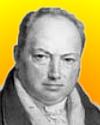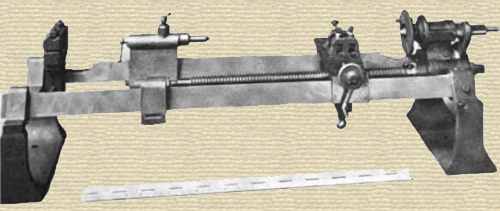 (source)
(source)
|
Henry Maudslay
(22 Aug 1771 - 14 Feb 1831)
British engineer and inventor who designed the metal lathe with slide-rest, and who developed his workshop and trained his employees to machine products with great accuracy.
|
Henry Maudslay and Modern Tools.
from The Mechanical Equipment (1918)
[p.201] Modern tools really had their beginning with the application of the “slide rest” principle to turning lathes by Henry Maudslay, a principle which has been extended to nearly every form of machine tool. It was first developed by Maudslay between 1790 and 1800 in the shop of Joseph Bramah, in London. Instead of being manipulated by hand, the cutting tool was clamped solidly in a tool post carried on a slide rest movable along accurately finished guides on the bed of the machine. For many years the slide rest was known in English as “Maudslay’s Go-Cart.”
In its first and simplest form the motion was controlled by hand-operated screws. In a short time, provision was made for connecting the operating screws by gearing to the driving spindle, giving the tool a power feed. This invention enormously increased the accuracy of the machine as well as the size of the cuts which could be taken. The old hand tools had to be skillfully used, for occasionally they “dug in” and lifted the workman over the lathe.
The lead screw, for which, also, Maudslay is responsible, followed within a very few years, and was a natural development from the slide rest. In its first form, Figure 45, a lead screw with the same number of threads per inch as it was desired to cut, was attached to a slide rest and driven at the same speed as the work. This caused the cutting tool in the slide rest to move forward over the work and generate the screw thread required. It, of course, necessitated a separate lead screw for every pitch to be cut. Within a year or so Maudslay developed the idea[p.202] of a single lead screw, much more accurately formed, which could be made to cut any pitch of thread by changing its turning velocity, relatively to the work, through a gear reduction. The various gears used to change the speed of the lead screw are still known as “change gears.”

These essential features of the screw-cutting lathe, although varied in proportions and greatly improved in workmanship, remain unchanged in principle to this day. Maudslay lived until 1830; shortly before his death he built a lathe capable of turning work 12 feet in diameter and boring steam cylinders up to ten feet in diameter, which shows the remarkable development in this machine during the lifetime of one man. So important were Maudslay’s contributions that he may well be termed the father of modern machine tools. The back gears used to increase the power of the drive were invented by Richard Roberts about 1817. From 1830 onward there was little development in the essential design of the turning lathe until, about 25 years later, the turret lathe was developed, and later still the automatic turret lathe. Both of these are American in their origin.
- Science Quotes by Henry Maudslay.
- 22 Aug - short biography, births, deaths and events on date of Maudslay's birth.
- Henry Maudslay - English and American Tool Builders (1916)
- Henry Maudslay & the Pioneers of the Machine Age, by John Cantrell and Gillian Cookson (eds). - book suggestion.




